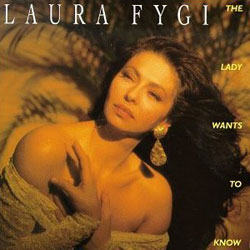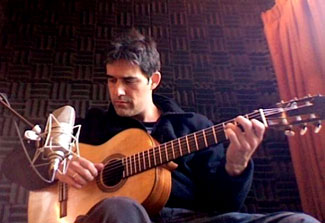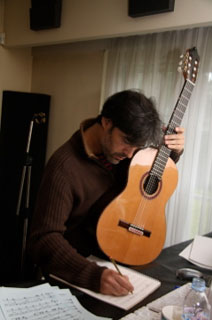

|
Soundclip:
|
| See
Steve's Hand-Written Solo Transcription |
|
Leonardo Amuedo's solo on: "Sabor a Mi"(Álvaro Carrillo) I probably first met Leonardo Amuedo, here we will refer to him as Leo, during a European tour in the early to mid-'90s, when I was playing with Anthony Jackson and Dennis Chambers, or Dave Weckl on drums. We had the good fortune to have been booked into Parker's Jazz Club in Amsterdam. Though born in Montevideo, Uruguay, Leo spent several years living and working in the Netherlands, before eventually settling down in Rio de Janeiro, Brazil. He has reminded me several times of our initial meeting and conversation that night in Amsterdam, and he even tells me that he mailed me a cassette to my then P.O. Box in New York. And that, apparently, I really liked what I heard, and sent him back a letter, via real mail, to encourage him to keep going, and to, above all, record himself. It was not so long after that, though it was quite disconnected, I discovered Leonardo Amuedo's superb playing on a Laura Fygi album titled, "THE LADY WANTS TO KNOW"(Verve/Forecast), which had been recorded between 1993-94, much of it having been recorded in Amsterdam.  There were many things that struck me about this particular album, but I just couldn't get over how spectacularly beautiful Leo's solo was on the great bolero "Sabor a Mi." This particular album is really dedicated to a Brazilian feeling for virtually all the songs, and the track to which I am referring is given a light bossa nova treatment. There were many things that struck me about this particular album, but I just couldn't get over how spectacularly beautiful Leo's solo was on the great bolero "Sabor a Mi." This particular album is really dedicated to a Brazilian feeling for virtually all the songs, and the track to which I am referring is given a light bossa nova treatment.Composed by Mexican singer/songwriter, Álvaro Carrillo, "Sabor a Mi" represents one of the most enduring and beautiful ballads in the Spanish language. Its message is romantic, sensual and timeless, a beautiful song for any period. Laura Fygi is a singer who can interpret songs in many languages as her background by birth is as multi-cultural as one could imagine. But Spanish, be assured, is not her native language. All the arrangements for this album were done by the masterful Jurre Haanstra, who is, to these ears, one of the great arrangers in the world! His sense of lush harmonies and the gorgeous blending of woodwinds and strings here is just superb. Listening to the Intro to this tune alone tells you virtually everything that you need to know about the man's soul. I've never met him, but he certainly has my great admiration. As Leo's solo arrives, Laura has already sung a full [A]-[A]-[B]-[A] chorus, with the first [A] sung rubato with the orchestra before the bossa nova rhythm kicks in at [A2]. Leo's 16-bar solo arrives and stands as a work of near perfection, but don't expect me to find fault with any of it! The song is performed in Db major which, to me, is a wonderful key because it just has a very warm and dark quality to it, perfect for the romance of a beautiful ballad like this one. Like any great song, "Sabor a Mi" offers chords that could be treated in any number of ways, and you can listen to the very popular version by Trio Los Panchos and hear any number of differences. What is unmistakable is the Spanish guitar style that introduces the song, and perhaps this style served as some sense of direction for Leo Amuedo, whose solo really embodies almost the entire history of this grand old instrument, the nylon-string guitar. So, with this particular analysis, as he only solos over [A] and [A2], I will offer my impressions and comments over each phrase as it appears. The pick-up to the solo is played over a Bb7(b9) chord, which under normal circumstances might make one think that we are headed towards an Ebm7 chord, but, we actually begin the section on the IV chord, Gbmaj7 which sounds terrific. Leo's opening phrase is perfect, it's simple and romantic and the 2nd piece of it seems to answer the first part. One thing that I noticed as I transcribed the solo is that, there are really never any long or sustained notes. When Leo takes a breath, this is preceded by a short note, and you can see this in bars 1 & 2 of the first [A] section. One musical note, where the B7(13) chords are concerned, and that is that, if I was to rigidly stick to the flats indicated by the key of Db major, I should really have labeled this chord as Cb7(13). But, by convention, most arrangers and musicians forego this, and choose to use the more visually simple B7. You also see the first appearance of, what some might describe as a Spanish guitar ornament at the end of bar 1,  but this kind of phrasing mannerism is just as prevalent in the Jazz world as well. I guess there would be those who might say that they hear the presence of the great Django Rheinhardt here. Honestly, I can't say that with any certainty, because I've never spoken to Leo about this solo in that way. but this kind of phrasing mannerism is just as prevalent in the Jazz world as well. I guess there would be those who might say that they hear the presence of the great Django Rheinhardt here. Honestly, I can't say that with any certainty, because I've never spoken to Leo about this solo in that way.As the 2nd phrase begins, I have to point out Leo's tremendous rhythmic control in his phrasing. The difference between executing triplets and then 16th-notes is not at all as simple as one might imagine. And to do it with this kind of grace and elegance is testament to the talent of this brilliant guitarist. In bar 3, we see yet another guitar ornament, and again, who is to say if this is a Spanish-style guitar technique or a Jazz phrasing technique? It could easily be either one. In bar 4, as Haanstra's arrangement inserts the passing Em7 chord between Fm7 and Ebm7, Leo observes this change with his lines, and takes advantage of the sound of the lower register of our instrument. That low B-natural is the lowest note we will see in this particular solo. As the phrase comes to an end, between bars 5-6, the jump between Gb-F to F-Gb up an octave is very expressive, and a great example of symmetrical melodic phrasing. Beginning with the pick-up into bar 7, he has now arrived in his upper register, and notice how the phrasing alternates between triplets and a grouping of an 8th-note and 2 16th-notes. The phrase in bar 8, again continuing the ascent in register, offers a bit of the blues language of the guitar, so pay attention to the expressive grace-notes where they appear. That blues phrase that I mentioned brings the solo into [A2], and between bars 1-2, Leo answers the initial phrase with another blues reference over the F#m7(9)/B sonority. Perhaps it's worth noting that as he entered the Gbmaj7 chord in bar 1 of [A], he landed on a Bb, the 3rd of the chord, and the pivotal note in bar 1 of [A2] is also a Bb, in the same register. From the pick-up into bar 3, he offers yet again some expressively executed triplets, and take note that all these notes are purely diatonic within these chord changes. It reinforces the notion that to be melodic and expressive does not mean that you have to be exploring the outer realms of linear harmony! In bar 4, he vaults up to a high Ab, which takes the solo to its apex, in terms of register. And it is this particular moment, between bars 4-6 where Amuedo offers the most Jazz-oriented phrases of the entire solo. The little ornamentation that you see/hear over the Fm7 chord, to these ears, has some affinity with Django's phrasing, which certainly connects everything to the language of Jazz. From beat 4 of bar 4 through beat 1 of bar 5, his phrasing has a particular swing feeling to it, which is so great to hear against the very up-and-down, even 8th-notes of the bossa nova rhythm. Notice the usage of the D-natural, the #7(major 7th), over the Ebm7 chord. Again, it should be really seen as more of a a chromatic lower neighbor than putting to use the Eb melodic minor scale. After another breath, the last phrase of the solo is simply spectacular as Haanstra offers a version of the plagal cadence, here: Imaj7-ivm7-Imaj7 or Dbmaj7 to Gbm7(6) back to Dbmaj7. Leo observes this perfectly by playing a Bbb(m3rd) to mark the chord change to Gbm7. From a guitar perspective, he descends with a gracefully executed sweep down a Gbm triad, and concludes with yet another very jazzy 16-note triplet ornamentation cadencing on F-natural, the 3rd of Dbmaj7 on beat 1 of the final bar.  This, of course, leaves a space for Laura Fygi to enter with her vocal pick-up to the [B] section of the tune. This, of course, leaves a space for Laura Fygi to enter with her vocal pick-up to the [B] section of the tune.Throughout this solo, I have tried to point out various aspects to the phrasing, to the self-confident control of the variety of rhythms that appear, but, what becomes so difficult to notate, no matter who the player might be, is the elasticity of someone's particular phrasing. Here I am speaking of Leo Amuedo's ability to lay back, to purposely play behind the time, and then, even within a phrase, to aggressively play on top of the time feel. A mature player must be able to do both of these things, having learned just how very expressive this can be. To me, this is a solo that you could listen to 100 times, and hear something new or different each time. It's just that good, that brilliant! For me, it has been a great pleasure to present this gorgeous solo of Leo Amuedo's here at these pages after all these years. In truth, Leo and I really only reconnected face-to-face for the first time since Amsterdam this past year of 2011. But, the warmth of the friendship that exists between us extends beyond all the correspondence over the years. The fact that he is a superb, world-class guitarist, with talents on the instrument that I could only dream about possessing, does not exclude that he is also a warm and wonderful human being, blessed with a beautiful spirit and optimism about life and music. For him, perhaps this solo does not represent anything particularly special, after all, in his hands, it sounds completely effortless. In the end, all great playing seems to sound that way - if one sounds like they are trying too hard, this never projects anything positive! Perhaps the lesson here is that you must remember that something very special and magical can be somehow packed into a mere 16-bars, and stand forever as a great work of art. From the moment that I first heard it until now, this "Sabor a Mi" solo remains just that, a work of art! Bravo Leo!!! Once again, from KHAN'S KORNER 1, we are wishing everyone a terrific summer here in 2012.
[Photos: Leonardo Amuedo
Courtesy of: Otto Vowinkel - Luthier] |